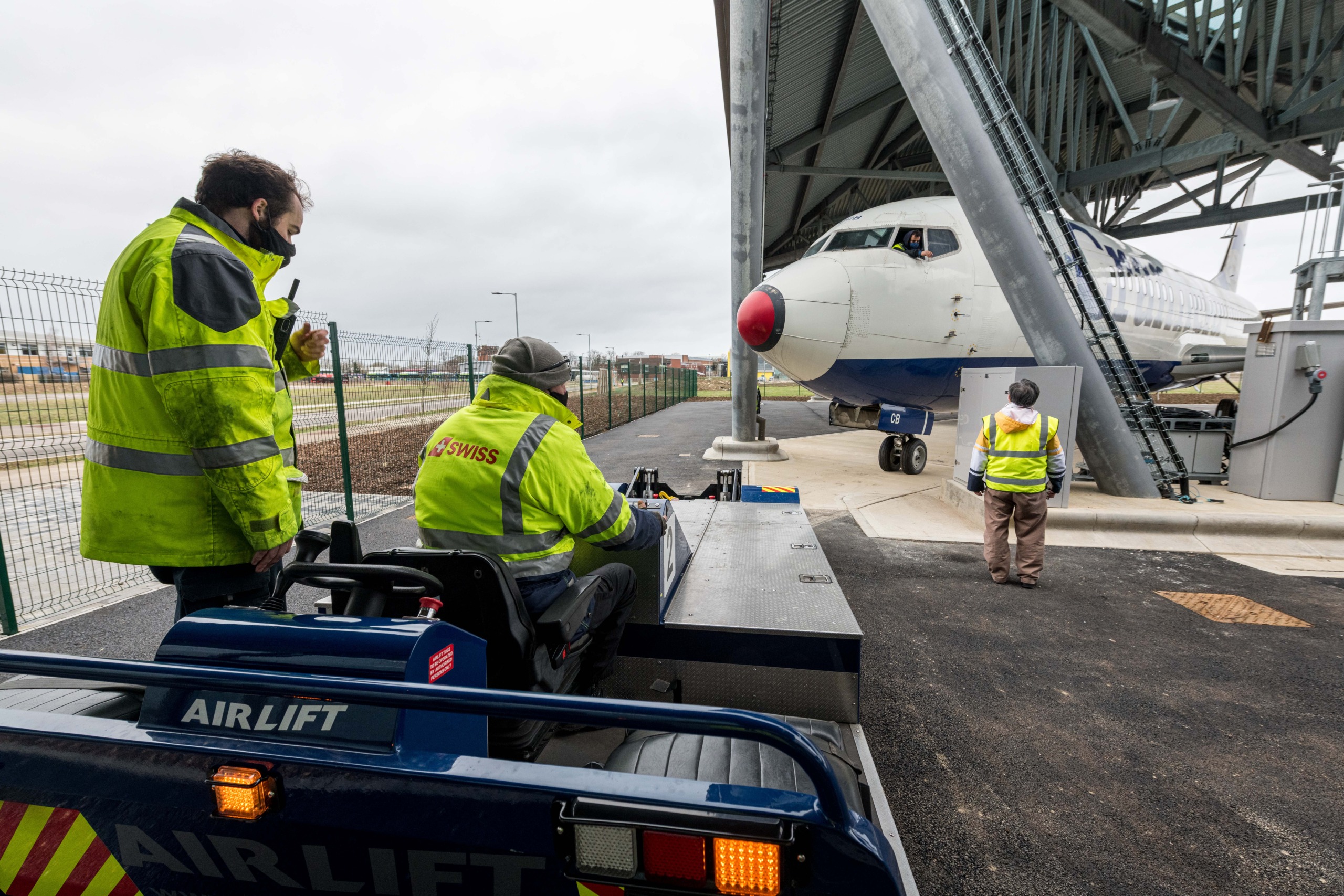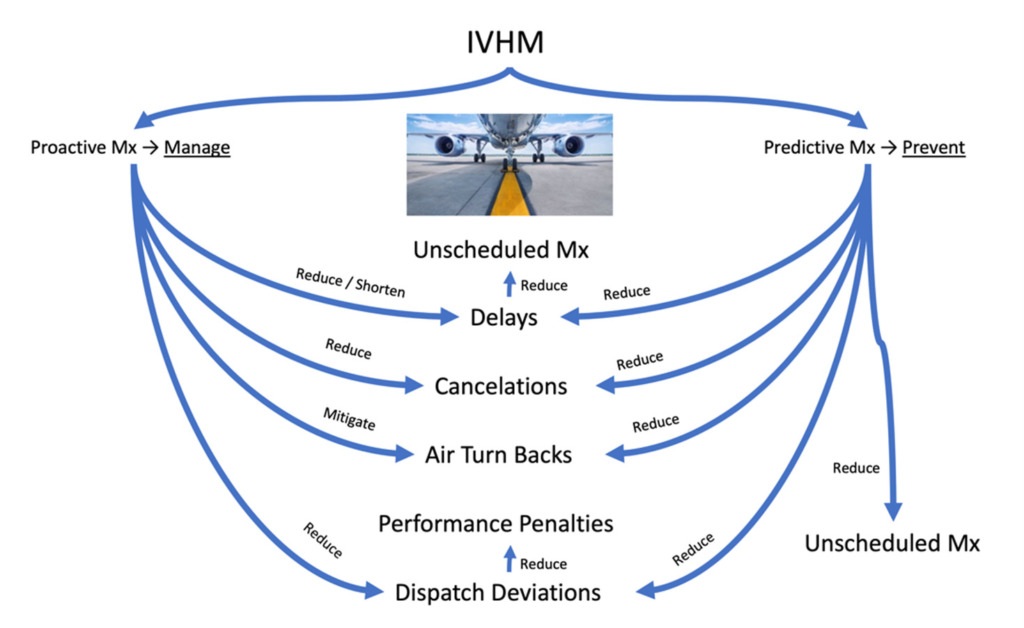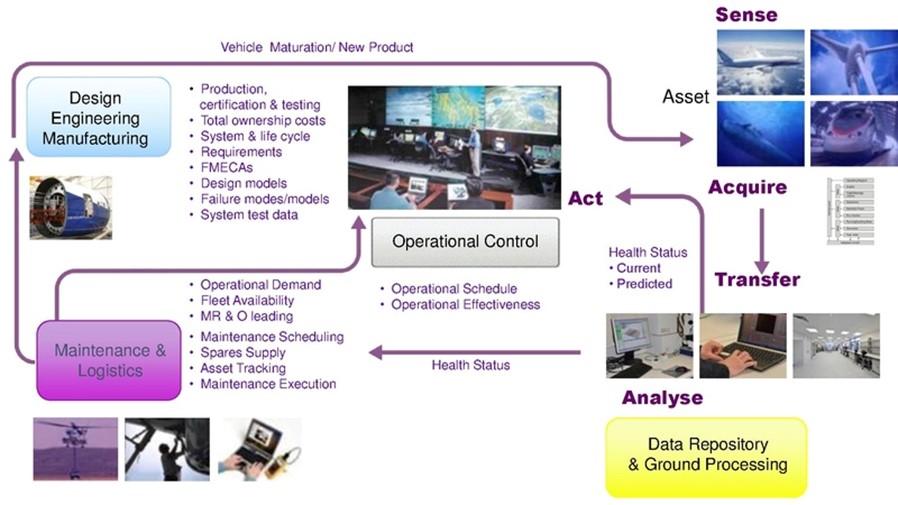Words matter – a conversational Integrated Vehicle Health Management lexicon
26/01/2023

There are many well established barriers to successful digital transformation which prevent full realisation of desired benefits. It is generally recognised that only 30% of digital transformation efforts deliver these results. One of the most preventable factors is the in-exact usage of terminology within the organisation undergoing transformation. A well understood lexicon is required to avoid conflating terms, which leads to confusion. This often manifests itself in communications across levels within the organisation, where leaders hear terminology and give direction using these terminologies incorrectly, thus driving potential misdirection and wasted efforts.
Integrated Vehicle Health Management (IVHM), while perhaps not commonly thought of as “digital transformation”, is very much so. It is using data throughout the vehicle lifecycle to make operations more efficient and sustainable. This blog provides a conversational, jargon-free, lexicon to help with clear communications around IVHM and associated areas.
Health Management
“Health Management” refers to the use of data to manage the current or future serviceability of an asset. “Serviceability” is the degree to which an asset can achieve its intended mission. Of course, in the case of IVHM, the asset is a “vehicle” and, for the purposes of this blog, we’ll assume that the vehicle is an aircraft or is related to aircraft or their operations. Aircraft Health Management, Airplane Health Management and Engine Health Management (EHM) are specific applications of health management to assets. Obviously, “airplane” is a sub-set of “aircraft”. It is also worth noting that much of the early innovation and investment in this area was pioneered by the engine OEM’s EHM activities.
“Condition Monitoring” is a common term which is highly associated with Health Management. “Condition” describes the state of an asset. It may refer to component failures, trends, performance, etc. It is most often used within the context of maintenance approaches, as in “Hard Time”, “On-Condition” and “Condition Monitoring”, with the latter referring to Proactive or Predictive Maintenance. These are within the family of activities sometimes referred to as Reliability Centered Maintenance.
“Proactive/Predictive Maintenance” are complementary terms, and related to Health Management, but with focus on actual maintenance activities. Proactive Maintenance is around using data to manage a condition or failure which has already occurred. For example, moving the planning to the “left” so the fix/fly decision can be made as soon as possible, with the highest degree of accuracy, in the most efficient manner possible. Predictive Maintenance builds upon Proactive Maintenance to use data and information to predict with a reasonable certainty that a failure or condition which will impact serviceability will occur before it happens. Figure One illustrates how both Proactive and Predictive Maintenance yield quantifiable value to aviation operations.

Figure 1 – Proactive/Predictive Maintenance Value Elements
Predictive Health Management is commonly used in engineering. It refers to techniques, sensors, computing related to the “prognostic” elements of health management.
Prognostics are generally methods or algorithms which are deployed to attempt to model an expected future event. In contrast, Diagnostics refers to methods to determine exactly what has happened to facilitate efficient return to serviceability.
Condition Based Maintenance (CBM) is generally used within the military applications of health management. In its simplest form, CBM can be seen as the use of data to perform proactive maintenance using data within the military aviation domain. In addition, “CBM+” refers to the predictive maintenance within the military aviation domain.
Non-Destructive Testing (NDT) techniques are largely used because of the outstanding advantages that they are capable to provide in a variety of applications. It is the process of inspecting, testing, or evaluating a component or system in order to identify (diagnose) anomalies or defects without destroying the serviceability of the part or system. In other words, when the inspection or test is completed the part can still be used. NDT is also known as Non-Destructive Evaluation (NDE) and/or Non-Destructive Inspection (NDI). There are various types of NDT such as visual inspection, radiography, ultrasonic testing, magnetic particle testing, liquid penetrant testing, electromagnetic testing, thermal/infrared testing, etc. Each type has its own advantages depending on the application.
Integrated Vehicle Health Management (IVHM) brings all of these together. IVHM is a broad scoped term encompassing all of the foregoing, and more. IVHM is the unified capability of systems to assess the current or future state of the member system health and integrate that picture of system health within a framework of available resources and operational demand. It is a very wide-reaching capability encompassing: business cases and models; legislation, certification and standards; architecture and design; as well as algorithms for prognostics, diagnostics and reasoning. Figure 2 below shows an IVHM Concept and how IVHM is applied across the lifecycle.

Figure 2 – IVHM Concept Schematic Extracted from “Integrated Vehicle Health Management – Perspectives on an Emerging Field”, Ian K. Jennions
There are several adjacent areas which, while not exactly IVHM, are related in that they use data to solve operational issues. These include:
- Optimised Maintenance Program (OMP), which uses in-service data to optimise an operator’s regulatorily approved scheduled maintenance as established in the OEM Maintenance Planning Document (MPD). Often OMP uses the analytics techniques discussed above, such as NLP “reading” of actions taken from mechanics’ tech logs.
- Flight Operation Quality Assurance (FOQA), which uses flight data to provide analysis of and feedback to pilots on their flight performance. MFOQA is Military Flight Operation Quality Assurance, which is self-explanatory.
- Digital MRO is a key related term. MRO stands for “Maintenance, Repair and Overhaul”, and is commonly used throughout industry. In the aviation ecosystem it can refer to a family of maintenance activities, or colloquially as an entity (e.g., an MRO facility). Digital MRO refers to information tools and capabilities which support efficient MRO operations. IVHM is a part of this domain.
Digital
The term “Digital” is used in several contexts within the IVHM ecosystem, as we have seen with Digital MRO, above. Some selected most associated with IVHM uses are discussed here.
Digitisation generally refers to converting analog data sources into digital format. In aviation there has been an enormous paper to digital transition over the last 20 years. Digitalisation is defined as the adaptation of a system, process, etc. to be operated with the use of computers and the internet. Digital Twin is a widely used (and often misused) term. In short, a Digital Twin is a virtual model which represents a physical object or space. Importantly, not every model is a “digital twin”. Relatedly, Digital Threads are applied across through-life of the asset, including design, manufacture, in-service.
Analytics
Obviously, the discipline of Analytics is vast. Analytics, data science, and related topics are some of the most often confused concepts when discussing IVHM, especially since these terms have become increasingly used by the public. The following covers only the most IVHM-applicable analytics terms in a very simplified form.
Data Science is a STEM discipline devoted to using software tools and mathematical methods to solve real-world problems. Collectively these are sometimes called Analytics. A classic use case of analytics is Data Mining, which is using analytics tools and methods to glean meaning from large and complex data sets to increase understanding or to establish meaningful relationships.
Artificial Intelligence (AI) is a family of activities which seek to emulate the human intelligence in one form or another. Several activities used in IVHM fall under the umbrella of Artificial Intelligence. These include Machine Learning (ML), which focuses on the application of use of algorithms and tools to emulate the way that humans learn. ML is often used in IVHM to explore and understand very complex data sets. A sub-category of ML is referred to as Deep Learning, which uses neural networks to automatically discover useful, higher-level features of data based on lower-level features. Another sub-category of AI which is commonly employed is called Natural Language Processing (NLP). NLP “reads” unstructured data such as free text so that machine readable information can be extracted.
Summary
In summary, IVHM covers a broad swath of the aviation digital transformation domain and has many possible constituent parts. As with all digital transformations, value delivery is key. Many of the words used in this area have subtle differences in meaning and can easily be misused. Their misuse can reduce the speed and efficiency by which value is delivered. We hope that the above provides some useful clarifications.
Further reading:
- “Air Carrier MRO Handbook, Jack Hessburg, Published by Aviation Week
- Integrated Vehicle Health Management – Perspectives on an Emerging Field”, Edited by Ian K. Jennions, Published by SAE International
- Intelligent Fault Diagnosis and Prognosis for Engineering Systems, George Vachtsevanos, et al, Published by Whiley
Acronym summary:
IVHM – Integrated Vehicle Health Management
EHM – Engine Health Management
OEM – Original Equipment Manufacturer
CBM – Condition Based Maintenance
NDT – Non-Destructive Testing
NDE – Non-Destructive Evaluation
NDI – Non-Destructive Inspection
OMP – Optimised Maintenance Program
FOQA – Flight Operation Quality Assurance
MRO – Maintenance, Repair and Overhaul
AI – Artificial Intelligence
ML – Machine Learning
NLP – Natural Language Processing
About the authors:
Professor Nico Avdelidis, Professor & Head of the IVHM Centre at Cranfield University. Professor Avdelidis (Nico) is a Professor and Head of the Integrated Vehicle Health Management (IVHM) Centre at Cranfield University since July 2020. The Centre is funded by a number of industrial partners such as Boeing, BAe Systems, etc. Nico is also a Professeur Associe (Adjunct Professor) at Universite Laval, in Quebec, Canada, where he does a lot of his research activities there in collaboration also with other organizations in Canada including the National Research Council (NRC Canada). Nico has contributed extensively to several research areas, such as non-destructive monitoring and diagnostics, robotic and autonomous systems in MRO, advanced sensing technologies, advanced IR imaging and image fusion using non-invasive techniques, and aircraft structures and/or systems monitoring.
John Maggiore, Senior Advisor to the IVHM Centre and Visiting Professor at Cranfield University. As a former Boeing executive leader, John developed a portfolio of digitally driven tools and capabilities plus served as The Boeing Company Executive Focal to Cranfield University during the inception of DARTeC. He is a digital aviation expert, with vast expertise in vehicle health management and digital MRO, holding two U.S. patents for innovations in analytics and vehicle health management. John is also an Executive Consultant in Seattle where he focuses on digital transformation and efficiency initiatives and is passionate about applying digital methods to support sustainability in aerospace. He is also a Fellow of the Royal Aeronautical Society.
Categories & Tags:
Leave a comment on this post:
You might also like…
Automotive Engineering: From student to hypercar innovation at Rimac
We sat down with recent graduate Thomas Perrin, to discuss how his year on the MSc in Automotive Engineering at Cranfield University propelled him from the lecture hall directly into the ...
What this year at Cranfield really meant to me
Every Cranfield journey is unique. In this alumni reflection, Zachea Scicluna shares what her year at Cranfield truly meant, from facing uncertainty to gaining hands-on experience in industry-backed projects. I’ve been reflecting (and delaying) ...
Preparing for assignments and exams?
Sorry! We know it seems a bit mean to mention the exams in January rather than looking forward to the break before it! However, we know many of you will be thinking about your forthcoming ...
Screening for FTSE 100 companies on Bloomberg
So you’re researching an index and need some data on its constituent companies? Bloomberg’s Equity Screening tool makes light work of this, not just for the FTSE, but for indices, exchanges and sectors worldwide. Type EQS ...
Accelerating my future: How Cranfield put me on the fast track to automotive safety innovation
Hello! I’m Michaela Kaiser, and I’m thrilled to share my journey studying abroad. I’m from Calgary, Canada, and I recently graduated from Cranfield’s MSc Automotive Engineering course. My path to Cranfield ...
From Myanmar to Cranfield: My path to Renewable Energy
As someone who is passionate about sustainability, my career goal is to build a path in the renewable energy sector. My aspirations comes from the benefits of developing sustainable energy sources and ensuring energy ...






